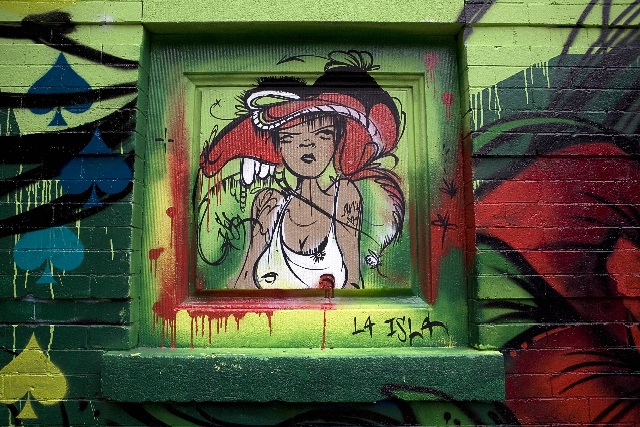Graffiti Girls

Image courtesy of Sofia Maldonado
Pink, fleshy girls spray-painted on the side of Q subway car. Big, naked bodies scrawled on skateboard ramps. A high heeled goddess in day-glo pink drawn on a brick wall.
Two striking things about graffiti art by women: It’s rare, and it’s loud–big, bright and, most of the time, naked.
How come? “I think it’s because it’s empowering,” explains curator and graffiti historian Karla Murray, whose buzzy graffiti exhibition opened on the rooftop of Gawker Media’s Nolita offices last month. (Pieces from the show are now on view at the city’s Clic Gallery through Sept. 27.) She added: “They are strong and sexy and can stand out among all the boys.”
Right now, Murray and her co-curator husband James are putting together “Graffiti Gone Global”, a sweeping international survey of contemporary graffiti. Premiering during Art Basel Miami Beach in December, it’s an unusual graffiti show in that approximately one third of the artists are women. In the mix are Ecuadorian-born Lady Pink, perhaps the most famous female graffiti artist (her work in is the Elizabeth Sackler collection of feminist art at the Brooklyn Museum, the Whitney and the Metropolitan Museum of Art), Aiko (part of the Faile collective), and Sofia Maldonado, one of the few U.S.-based artists invited to the Cuban Biennial.
But is all this breakthrough, or bandwagon? Most graffiti artists don’t get taken seriously until they bring their work inside. Mindful of that, Murray says, “All of the artists in our Graffiti Gone Global exhibit paint in the street, but also have shown their work in galleries.” But, while pioneer female graffiti artists Eva 62 and Barbara 62 were tagging subway cars as long ago as the 1970s, women have gotten short shrift, says Murray. Indeed, Lady Pink took the name “specifically so she could be identified as a female writer. She was taking the same risks as the boys by painting the subway cars on dangerous tracks and tunnels and going out late at night, so she wanted everyone to know she was female.”
Though the GGG show pairs respected curators (the Murrays were also responsible for “Storefront,” the well-reviewed photographic history of a disappearing New York) with an art-savvy sponsor (restaurant group Sushi Samba), there’s also a recession-inspired gimmick: The graffiti art in the exhibition will be for sale by the artists themselves.






